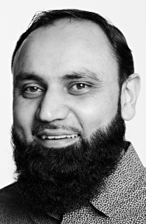Adam and Ben, the two CIOs from rival companies eyed each other head to toe as they entered the main conference hall from two different entrances, not deliberate but a welcome relief. As rivalry goes, nothing could be far worse in terms of Adam’s and Ben’s companies, always on the lookout to outdo each other. As the keynote speaker introduced her topic on the podium, both Adam and Ben knew this was big and was going to be a game changer. Both of them immediately sent a message to their senior management teams to inform them the topic of the key note. They continued to send messages throughout the speech, relaying what was being presented. This was no ordinary speaker; Maria was an expert in her field, when she spoke people not only listened but reacted fast.

Hasan Lorgat, Director & Principal Consultant
The BA Practice, hasanlorgat@thebapractice.co.uk
Once the standing ovation came to a close and the delegates dispersed for lunch, both Adam and Ben called their respective PAs to arrange a meeting with their senior management team for first thing when they were back in the office. For the remainder of the conference both Adam and Ben went about as they did at all the other conferences. Deliberately avoiding each other but if their paths would happen to cross they would exchange pleasantries as if they were the best of buddies.
Whilst Adam was still listening to the key note speech, Suzanne his head of enterprise architecture had already called a meeting with her principal business architect Mo. They both discussed the information that was being relayed to her by Adam and were quickly able to summarise it into a business opportunity statement, validating this with Adam before the key note speech ended.
After a brief discussion with his business architects, Mo identified which of the business capabilities would be impacted by this business opportunity. Mo’s business architecture team had an up to date business capability model which detailed the business capabilities for each of the business functions of the organisation. Mo verified this with Suzanne who then set out further meetings with her principal data, application and technology architects.
That afternoon Mo held a meeting with Antonio, the head of the business analysis practice to discuss the business opportunity. They both discussed the potential high level business processes that would be impacted. Antonio’s business analysis team had an up to date business process model which detailed the business processes down to an activity level for each of the business capabilities. Antonio verified this with Mo and set up meetings with his lead business analysts the following morning.
After the meeting with Mo, the lead business analysts produced a list of business processes potentially impacted and arranged meetings with their equivalent solution architects. The solution architects further identified the business services that would be impacted by the business processes. Adam had successfully implemented Service Oriented Architecture (SOA) a few years back. The solution architects had an up to date service repository that detailed each service and how each service was fulfilled by which technical component. By the end of the afternoon the solution architects had identified all the technical (application, data and infrastructure) components that would be impacted by the business opportunity,
The morning after the conference, Adam walked into his office and found his senior management team seated at his meeting table, he quickly shut the door behind him. Suzanne gave Adam a slide pack which he looked through quickly and smiled broadly. The presentation had detailed all the impacts; from business functions, business teams, business capabilities, business processes, business services to technical components. The slide pack also contained the estimated cost to implement this change. Adam congratulated his team and once they left his office he was directly on the phone to the CEO to arrange a meeting during lunch to sell this game changing business opportunity.
Likewise, the morning after the conference, Ben walked into his office and found his senior management team seated at his meeting table, he quickly shut the door behind him. Chris the head of enterprise architecture gave Adam a slide pack which he looked through quickly and frowned furiously. The presentation detailed the companies change lifecycle which he knew already; from presenting the business opportunity at the next new initiatives board to assigning a project which could take up to 6 weeks! Ben asked quickly for an alternative. Chris suggested they could work at risk but it would take 2 weeks to identify the business functions, business capabilities and the business processes potentially impacted. The head of development interrupted saying it would take a further 2 weeks to identify the technical components that would be impacted. He asked how much it would potentially cost but realised his team did not have any idea by the blank look on their faces. Ben plunged into his chair with his head in his hand and thought of Adam.
Traceability as a concept is something that is not applied/practised widely within organisations. At best, where it is used it is limited to requirements traceability, even this can go by the wayside when project timescales are challenged; or is completely ignored for the sexier Agile projects. Traceability is independent of the methodology being adopted and should certainly not be restricted to requirements.
Creating and adopting full end to end traceability is not an easy task, it is a time consuming, tedious and mundane activity. Maintaining traceability is laborious and requires real commitment. Ownership of traceability is most definitely a show-stopper.
As business analysts, we interact with stakeholders across the spectrum and have visibility of all the impacts. Hence, the business analysis function is best placed to take on the responsibility of creating, maintaining and ensuring the effectiveness of traceability both within and outside of projects.
From Adam’s experience the benefits of traceability certainly outweigh the effort and costs associated with it. The need to conduct impact analysis quickly and reliably is ever increasing and projects are becoming more and more complex. Therefore, having traceability is vital and will give companies a distinct advantage over those that do not have it.
The founder of The BA Practice, Hasan Lorgat is a successful business analyst from a consulting background. With over 20 years of hands-on experience. 12 of which have been spent operating as a freelance business analyst. He works on large strategic programmes for multiple clients, lately specialising in helping organisations improve their business analysis activities. Hasan is passionate about helping organisations build their business analysis capabilities, laying the foundations for delivering successful change. If your organisation understands the value in having a mature business analysis capability but is overwhelmed with delivering projects, Hasan would love to help.
Copyright, Hasan Lorgat, The BA Practice Ltd


